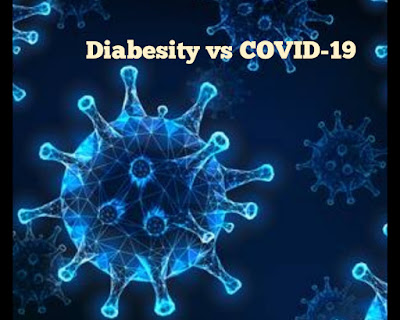DIABESITY: A tricky disease in times of Covid-19 Pandemic.
With this pandemic crisis, staying healthy is the key to fight any dreadful virus.
Diabesity: The Tricky Devil in times of COVID-19
By Dr David Heber, M.D., PhD, FACP, FASN – Chairman, Herbalife Nutrition Institute
We are fighting multiple health devils in our daily lives. While COVID-19 is the most recent one, it’s important that we do not lay our eyes off a few of those healthcare issues that have been afflicting the urban dwellers for long.
Non-communicable diseases, as we know, contributed 71% of the 56.9 million global deaths in 2016 . From this global burden, diabetes led to 1.6 billion deaths .
As of 2013, over 380 million people across the globe were affected by diabetes – a number expected to inch closer to 600 million by 2035. The Asia-Pacific region is generally considered the epicentre of the diabetes crisis. In these countries, people develop the disease earlier, get sicker, and die sooner than their counterparts in wealthier countries.
Meanwhile, most individuals with type 2 diabetes – roughly 80 percent – are considered obese, highlighting the strong association between diabetes and obesity.
“Diabesity”: Occurrence of diabetes in the context of obesity
It doesn’t necessarily mean that all obese folks develop diabetes; they don’t. But according to research conducted by the National Center for Biotechnology Information it does suggest a pretty direct connection, one that will only get deeper over time.
Owing to the strong correlation between the two, Sims and colleagues in as early as the 1970s, coined the term ‘Diabesity’. When defined, the term seems simple enough: diabesity is a convenient way of describing and discussing type 2 diabetes in the context of obesity. These two afflictions seem to converge and intersect more and more, popping up in many households and communities, among family and friends who have long struggled with their weight.
In addition, some people can appear to be of normal weight, and yet be carrying excess body fat. This is sometimes referred to as “TOFI” – thin on the outside and fat on the inside. This is especially common among Asians, South Asians, fashion models, and women who eat too little protein and remain sedentary.
Having Diabesity in times of COVID-19 is tricky
According to the World Health Organization, aged individuals and individuals with pre-existing non-communicable diseases such as diabetes, lung and heart conditions are highly susceptible to COVID-19 infection.
Excess upper body fat and abdominal fat constrict the lungs. These excessive fat deposits also increase susceptibility to pulmonary infections and exacerbate airway inflammation. Diabetes on the other hand is known to weaken the natural immune reflexes of the body.
In comparison to an average weighing person with no diabetes, these individuals will face higher risk of complications and may not respond to the treatments too.
It starts with mindful eating
The battle against diabesity and the risk of diabesity includes early detection, screening, prevention, health management, and personal behaviour. At the most fundamental layer of personal behaviour, it begins with healthier choices and mindful eating.
In times like this, healthcare practitioners are best positioned to guide their patients over and above the regular consultation to adopt the following dietary enhancements:
• Incorporate low glycemic food such as vegetables, whole fruits, beans and most 100% whole grains, which are high in fibre and promote satiety. These food types are also nutrient dense so that nutrition is maximized while limiting excessive calories.
• Add fish, lean meat and soy protein that are digested more slowly than highly-refined grains and help fight hunger
• Avoid “empty” calories like excessive sugar, salt, saturated fats and chemical preservatives that are often found or hidden in highly processed food
Make friends with movement
It is the sedentary lifestyle of the current age which, combined with the high fat, high sugar, and high starch diet, unmasks the genes for obesity. It is generally believed that the very obese (those over 100 pounds overweight or with a BMI >40), have the greatest genetic programming for obesity.
The American College of Sports Medicine (ACSM) recommends moderate physical activity of at least 2.5 to 5 hours a week for substantial health benefits. Saris et al. recommended at least 5 to 7 hours a week of moderate physical activity is necessary to prevent the transition of normal weight to overweight or overweight to obese. Exercise should include both cardiovascular activities and resistance training that target major muscle groups.
Using behavior change strategies
Successful weight management involves not only lifestyle changes (e.g. diet and physical activity habits) but also behavior modification. Scientific literature stresses three specific behavior modifications techniques that work when trying to manage weight:
• Self-monitoring
Research has consistently demonstrated that self-monitoring is associated with improved treatment outcomes, and patients report that it is one of the most helpful tools in weight management.
• Stimulus control
Identifying and modifying cues associated with overeating and inactivity can make it easier to maintain healthy habits. Controlling cues associated with overeating or a sedentary lifestyle can be helpful for long-term weight maintenance because exposure to these triggers may cause a weight regain.
• Stress management
Stress is a primary trigger or overeating, Deep breathing, muscle relaxation and meditation are proven stress reduction techniques and can reduce distraction from stressful events which can interfere with the adoption and maintenance of new behaviors.
Finally, higher levels social support is associated with greater success in weight management. Several independent studies show groups do not need to be primarily oriented toward weight management. Peer support can help people to become more self-accepting, develop interpersonal skills or new ways to manage stressful situations, all of which, in turn, might help with weight management objectives as a secondary positive consequence.
About Herbalife Nutrition Ltd.
Herbalife Nutrition is a global company that has been changing people's lives with great nutrition products and a proven business opportunity for its independent members since 1980. The Company offers high-quality, science-backed products, sold in over 90 countries by entrepreneurial members who provide one-on-one coaching and a supportive community that inspires their customers to embrace a healthier, more active lifestyle. Through the Company’s global campaign to eradicate hunger, Herbalife Nutrition is also committed to bringing nutrition and education to communities around the world.
For more information, please visit IAmHerbalifeNutrition.com.
Herbalife Nutrition also encourages investors to visit its investor relations website at ir.herbalife.com as financial and other information is updated and new information is posted.












Comments
Post a Comment